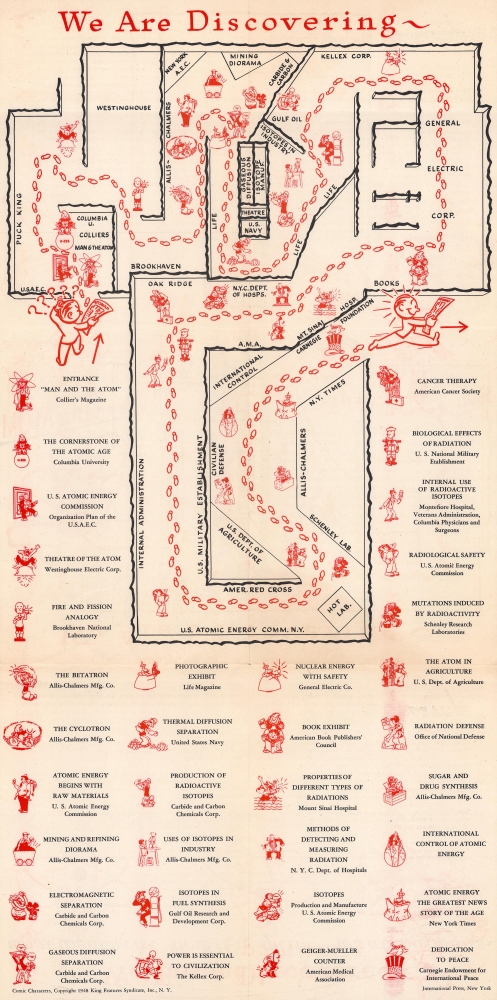1948 New York City Golden Anniversary Map of 'Man and the Atom' Exhibition
ManandtheAtom-nyc-1948$950.00

Title
Mayor's Committee for the Commemoration of the Golden Anniversary of the City of New York presents Man and the Atom.
1948 (dated) 21.75 x 10.25 in (55.245 x 26.035 cm)
1948 (dated) 21.75 x 10.25 in (55.245 x 26.035 cm)
Description
This is a 1948 map of the 'Man and the Atom' exhibit, illustrating the America's brief Atomic Crase. The exhibit was assembled for the New York City Golden Anniversary Exposition at the Grand Central Palace. It was the most comprehensive atomic exhibition presented to the public up to that time.
A Closer Look
The map begins at the entrance to the exhibit and presents a confused attendee holding an 'Atomap'. Footprints illustrate the proposed path through the exhibition, and cartoons mark displays. Below and surrounding the map on three sides is a legend connecting cartoons with displays, noting each display's name and sponsor. The map ends with the same attendee exiting the exhibition with a huge smile, beaming at the 'Atomap.''Man and the Atom'
'Man and the Atom,' was the 'most comprehensive atomic energy exhibit ever presented to citizens' (at least up to that point). The atomic energy exhibition featured a Van de Graff generator. Another display included a demonstration in a lead cube where dimes were temporarily turned radioactive by turning the silver in the dimes into cadmium. Other exhibits included a Geiger counter and illustrations of the medical uses of radioactive isotopes. High school students volunteered as guides, giving short, prepared speeches about the exhibits. General Leslie Groves, the former head of the Manhattan Project, helped design the exhibit and visited it a week after it opened.The Atomic Craze
The atomic craze in America during the 1940s was a cultural phenomenon that emerged in the wake of the development and use of atomic bombs during World War II (1939 - 1945). The public's fascination with nuclear energy and its potential was fueled by a mix of awe, fear, and curiosity. This craze was reflected in various aspects of American life, from science fiction movies and comic books featuring atomic-powered superheroes to the incorporation of 'atomic' themes in marketing, architecture, and consumer products. The atomic bomb's role in ending the war gave it an almost mythical status, leading to a widespread interest in all things nuclear, whether it was the promise of limitless energy or the looming threat of atomic annihilation. This period also saw the beginnings of the Cold War, which further intensified the public's fixation on atomic power as both a symbol of progress and a harbinger of potential doom.New York's Golden Jubilee Celebration
In 1948, New York City celebrated its Golden Anniversary - 50 years since the 1898 consolidation of the five boroughs into Greater New York. Grover A. Whelan served as Chairman of the Mayor's Committee for the Commemoration of the Golden Anniversary, which organized the event. It was held at the Grand Central Palace, a 13-story building between 46th and 47th Streets that served as New York's main exhibition hall from 1911 until 1953. The exhibition was open from August 23, 1948, until September 19, 1948. The entry fee was 50 cents, and the exhibition filled the first 4 floors of the Grand Central Palace. The exhibition was meant to display the inner workings of their city government to New Yorkers. Displays highlighted the functions of 102 city departments, including the Police Department and the Department of Water Supply. WNYC broadcast from the first floor. A 'fashion pageant' took place daily, and 120 models presented fashion from 'every price point.'Publication History and Census
This 'Atomap' was created for visitors to the atomic energy exhibition at New York's Golden Jubilee exhibition at the Grand Central Palace. This is the only known cataloged example.Condition
Very good. Light wear along original fold lines. Toning. Accompanied by a photo quiz made by Look Magazine.

